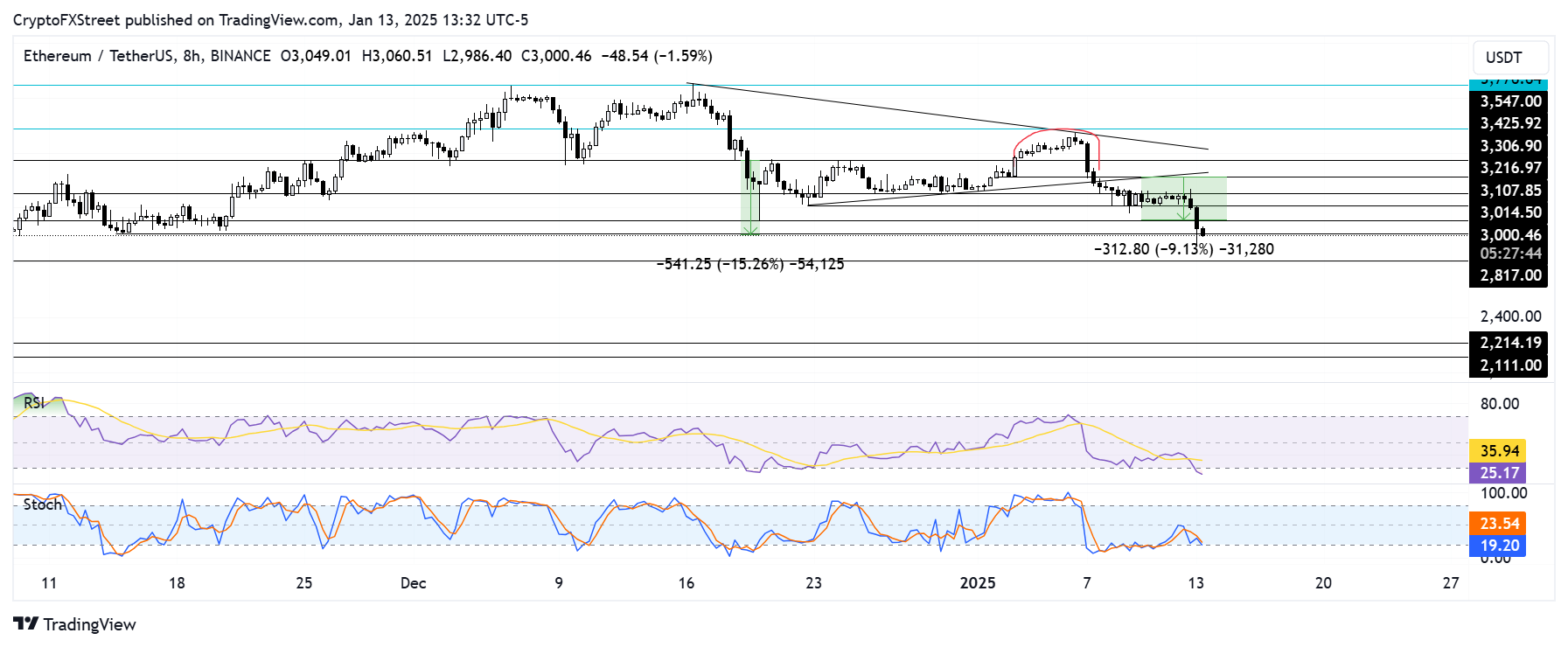Ethereum Price Forecast: ETH eyes support near $2,800 as investors book over $100 million in losses
Ethereum price today: $3,010
- Ethereum investors realized over $100 million in losses following increased signs of panic selling.
- The 30-day MVRV Ratio decline below 10% indicates ETH may see a recovery soon.
- Ethereum could find support near the $2,800 key level after an 8% decline.
Ethereum trades close to the $3,000 psychological level, down 8%, following over $100 million in realized losses. The top altcoin could bounce off the $2,817 support level after the 30-day Market Value to Realized Value (MVRV) Ratio declined below 10%.
Ethereum investors book losses as MVRV indicates signs of a potential price bounce
Ethereum opened the week with a decline as signs of panic selling increased among investors. The Network Realized Profit/Loss metric showed that investors booked over $100 million in losses in the past 24 hours.
 [18.19.58, 13 Jan, 2025]-638723922664378429.png)
Ethereum Network Realized Profit/Loss & Mean Coin Age. Source: Santiment
Despite the slight increase in realized losses, the Mean Coin Age metric, which measures the average number of days all ETH tokens have remained in their addresses, has remained in an upward trend. This indicates a slight bias toward the buy-side, as spot traders may be scooping up the dip.
Additionally, ETH's 30-day MVRV Ratio — which measures the average profit/loss of all investors who bought the token in the past 30 days — declined below -10%. ETH may see a recovery as prices tend to bounce whenever the 30-day MVRV Ratio crosses below -10%.
 [19.16.59, 13 Jan, 2025]-638723923093211993.png)
ETH MVRV (30-day). Source: Santiment
Meanwhile, US spot Ethereum exchange-traded funds (ETFs) recorded their largest weekly net outflows since July after shedding a net $186 million last week, per Coinglass data. The outflows spanned across all major issuers, with BlackRock being the only outlier to record net inflows of $124.1 million.
Ethereum Price Forecast: ETH could find support near $2,800 after 8% decline
Ethereum's 8% dive sparked over $182 million in futures liquidations in the past 24 hours, per Coinglass data. The total amount of liquidated long positions reached $152.50 million, while short liquidations were $29.84 million.
The top altcoin completed the target of a rounding top and double-top pattern on Monday after briefly declining below the $3,000 psychological level. If ETH fails to find support at $3,000, it could test the $2,817 level, which was held as a key support between April and July.

ETH/USDT 8-hour chart
A daily candlestick close below $2,817 could send ETH toward the historically high demand zone of $2,100 - $2,500, where investors purchased over 61 million ETH, per IntoTheBlock's data. However, a bounce off $2,817 could help ETH reclaim the $3,300 level.
The Relative Strength Index (RSI) and Stochastic Oscillator (Stoch) are in their oversold region, indicating ETH may recover soon.
A daily candlestick close above $3,550 will invalidate the thesis.
Ethereum FAQs
Ethereum is a decentralized open-source blockchain with smart contracts functionality. Its native currency Ether (ETH), is the second-largest cryptocurrency and number one altcoin by market capitalization. The Ethereum network is tailored for building crypto solutions like decentralized finance (DeFi), GameFi, non-fungible tokens (NFTs), decentralized autonomous organizations (DAOs), etc.
Ethereum is a public decentralized blockchain technology, where developers can build and deploy applications that function without the need for a central authority. To make this easier, the network leverages the Solidity programming language and Ethereum virtual machine which helps developers create and launch applications with smart contract functionality.
Smart contracts are publicly verifiable codes that automates agreements between two or more parties. Basically, these codes self-execute encoded actions when predetermined conditions are met.
Staking is a process of earning yield on your idle crypto assets by locking them in a crypto protocol for a specified duration as a means of contributing to its security. Ethereum transitioned from a Proof-of-Work (PoW) to a Proof-of-Stake (PoS) consensus mechanism on September 15, 2022, in an event christened “The Merge.” The Merge was a key part of Ethereum's roadmap to achieve high-level scalability, decentralization and security while remaining sustainable. Unlike PoW, which requires the use of expensive hardware, PoS reduces the barrier of entry for validators by leveraging the use of crypto tokens as the core foundation of its consensus process.
Gas is the unit for measuring transaction fees that users pay for conducting transactions on Ethereum. During periods of network congestion, gas can be extremely high, causing validators to prioritize transactions based on their fees.

